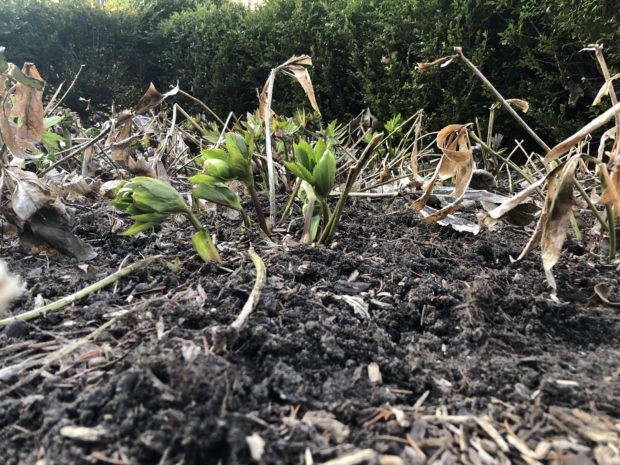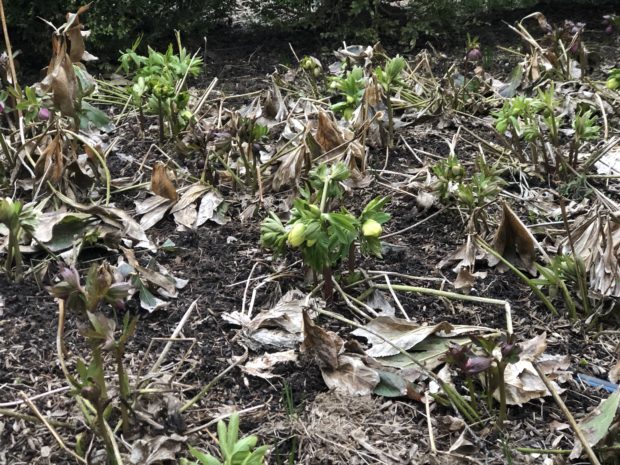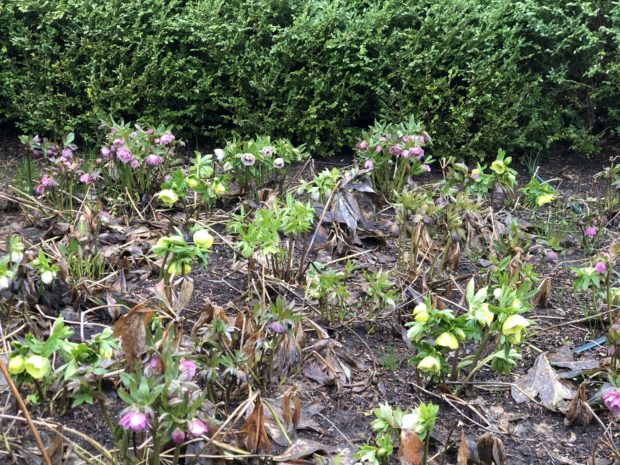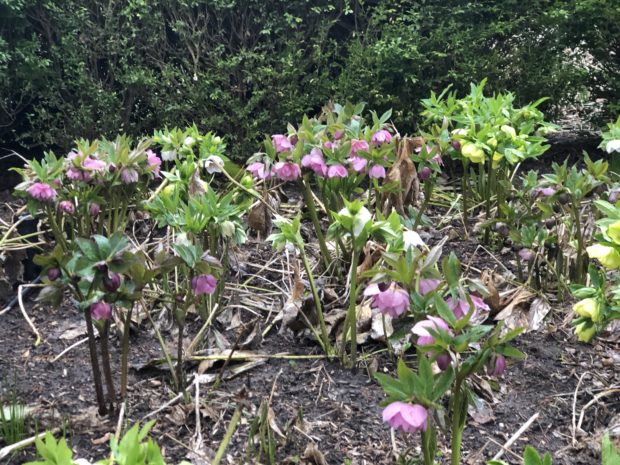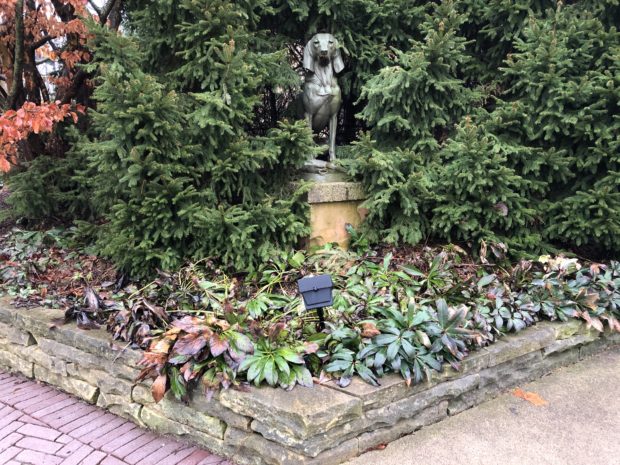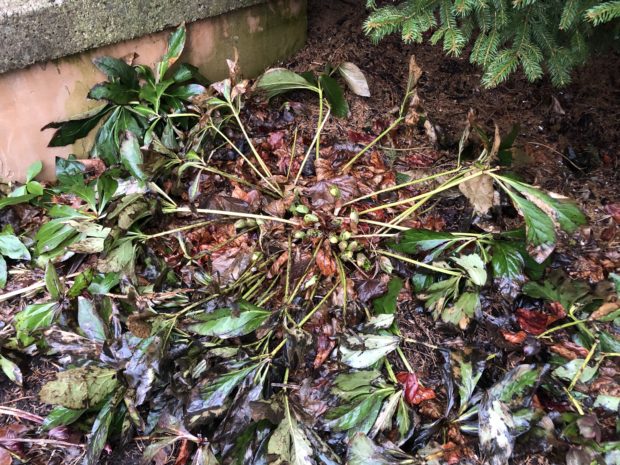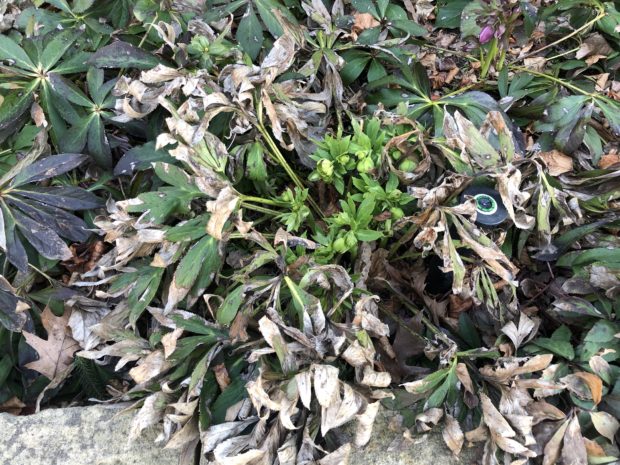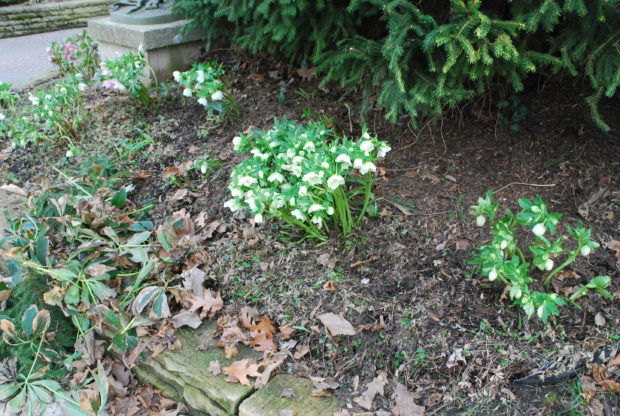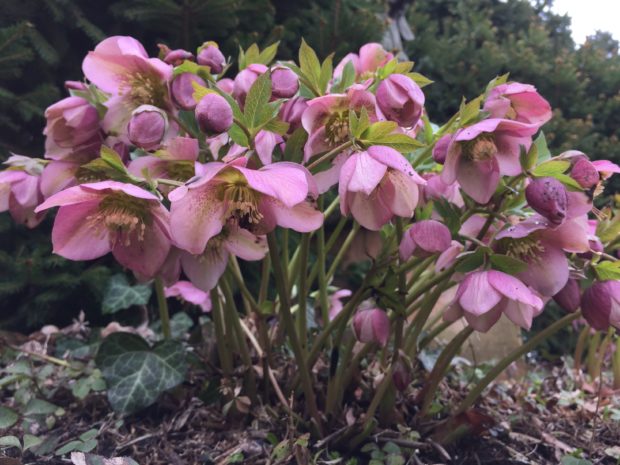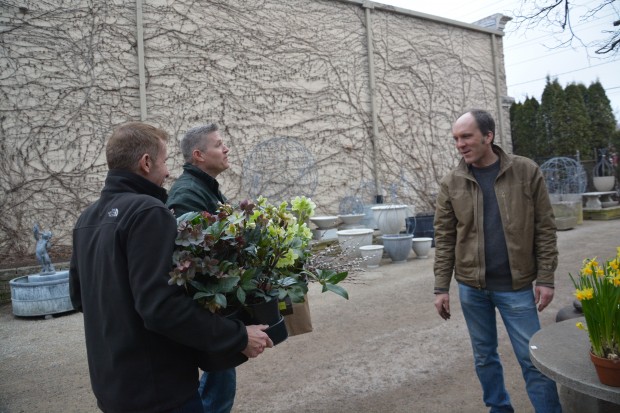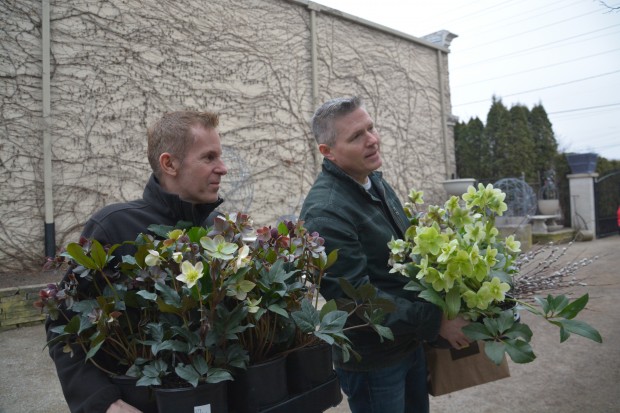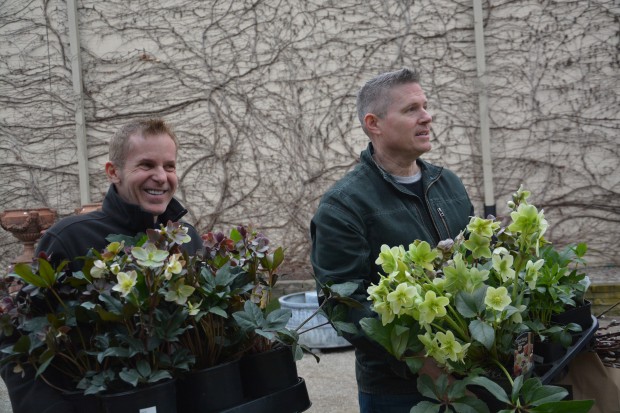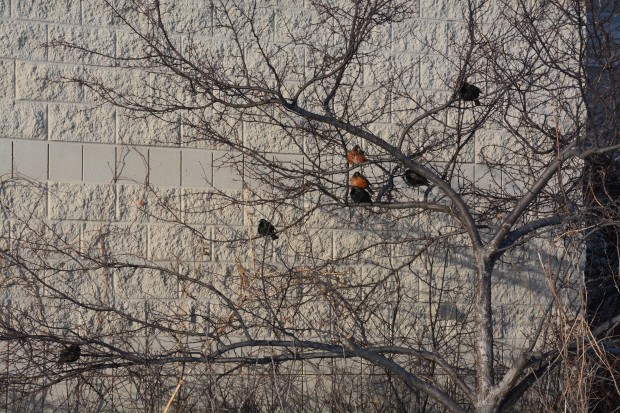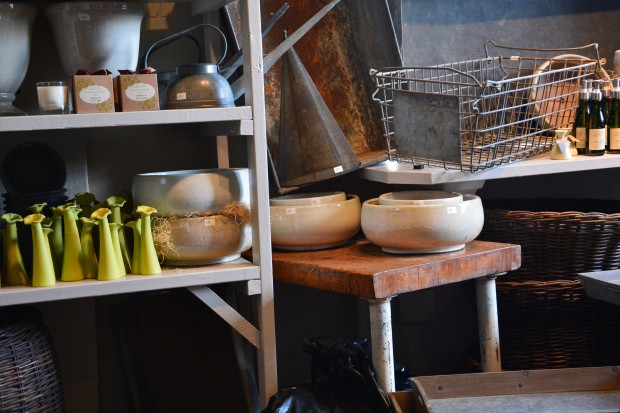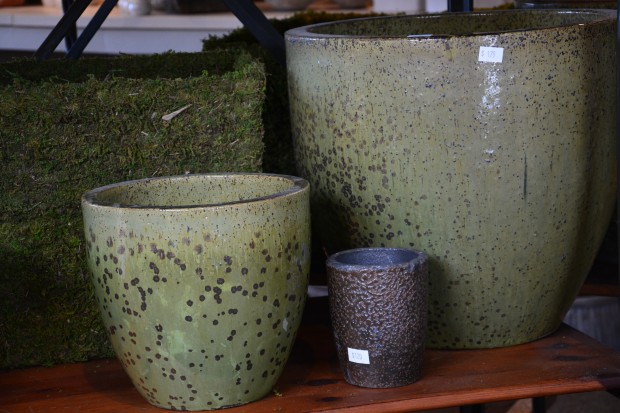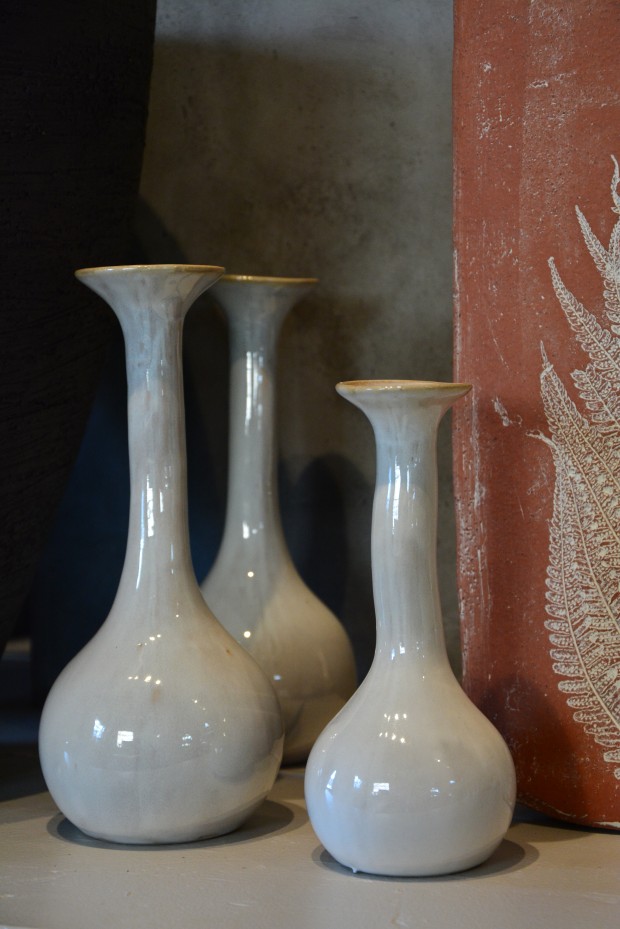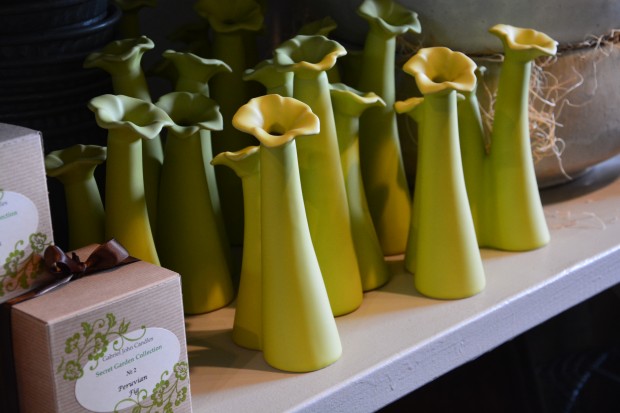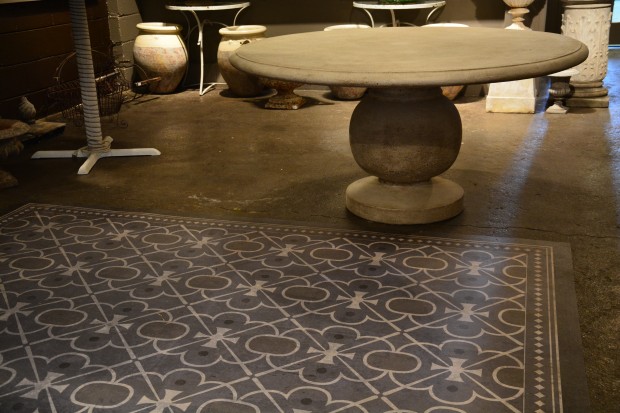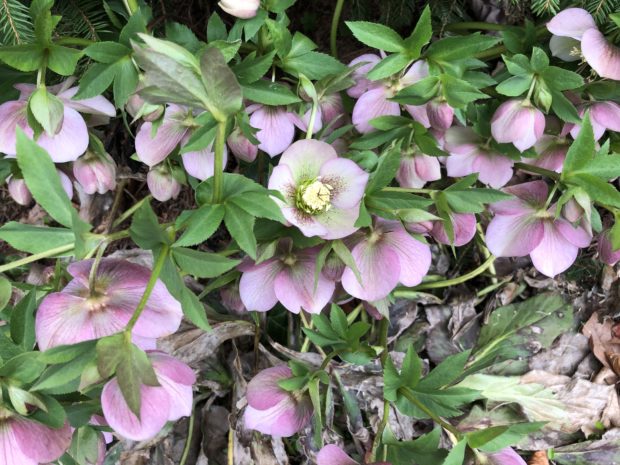 My first exposure to hellebores was likely in the 1970’s. Though gardening consumed every available moment and most of any available cash I had for plants, there were no hellebores in my yard. I could buy five other plants for the money it took to buy one hellebore. My Mom, on the other hand, being much more solvent than I, had an ever expanding collection. At first, I could not understand her fascination with them. Topping out at a foot or 16″ tall, it took 5 years to grow on a decent sized clump. The foliage was certainly attractive, but the flowers left quite a bit to be desired. Enjoying them was a necessarily interactive experience. The flowering stems were lax and thin. To enjoy them, one needed to bend over to half one’s height, pick up the drooping bloom, and turn it skyward. As pictured above, helleborus x hybridus varieties of old provided the gardener an excellent view of the flower’s backsides. The one flower looking at you was a bloom that I cut, and laid face up on the plant. Not that the back wasn’t beautiful, it just did not provide the thrill of a full front view. As in, face to face.
My first exposure to hellebores was likely in the 1970’s. Though gardening consumed every available moment and most of any available cash I had for plants, there were no hellebores in my yard. I could buy five other plants for the money it took to buy one hellebore. My Mom, on the other hand, being much more solvent than I, had an ever expanding collection. At first, I could not understand her fascination with them. Topping out at a foot or 16″ tall, it took 5 years to grow on a decent sized clump. The foliage was certainly attractive, but the flowers left quite a bit to be desired. Enjoying them was a necessarily interactive experience. The flowering stems were lax and thin. To enjoy them, one needed to bend over to half one’s height, pick up the drooping bloom, and turn it skyward. As pictured above, helleborus x hybridus varieties of old provided the gardener an excellent view of the flower’s backsides. The one flower looking at you was a bloom that I cut, and laid face up on the plant. Not that the back wasn’t beautiful, it just did not provide the thrill of a full front view. As in, face to face.
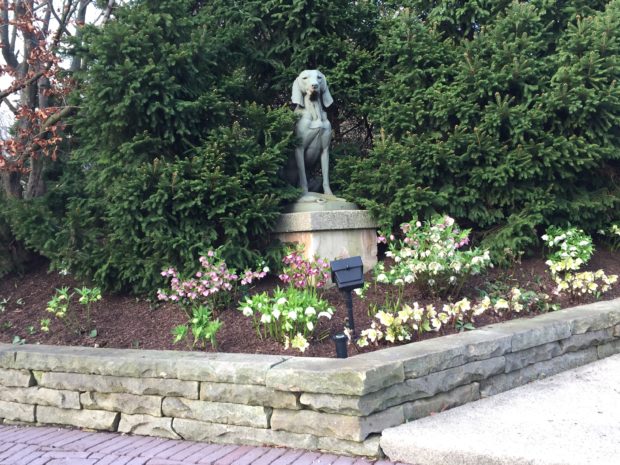 The flowers were about the size of a quarter or half dollar. They were broad and weighty compared to the stem. No wonder the flowers were nodding. Another more compelling reason for their down facing blooms is practical. Upfacing large flowers can suffer damage from rain and rot, that could interfere with the production of seed. The stalk attached to the flower is known as the peduncle. This word itself suggests something robust and strong, but the stems of these hellebore flowers could not have held a flower in the upright position. It always amused my Mom when I would lie down on the ground next to one of her plants, and try to peer up at the flowers. The colors of the flowers were equally as unsatisfying. The thin petals of the white flowered strains were a dirty white, most likely due to their translucence. The reds were overlaid with green, and the pinks were anemic.
The flowers were about the size of a quarter or half dollar. They were broad and weighty compared to the stem. No wonder the flowers were nodding. Another more compelling reason for their down facing blooms is practical. Upfacing large flowers can suffer damage from rain and rot, that could interfere with the production of seed. The stalk attached to the flower is known as the peduncle. This word itself suggests something robust and strong, but the stems of these hellebore flowers could not have held a flower in the upright position. It always amused my Mom when I would lie down on the ground next to one of her plants, and try to peer up at the flowers. The colors of the flowers were equally as unsatisfying. The thin petals of the white flowered strains were a dirty white, most likely due to their translucence. The reds were overlaid with green, and the pinks were anemic.
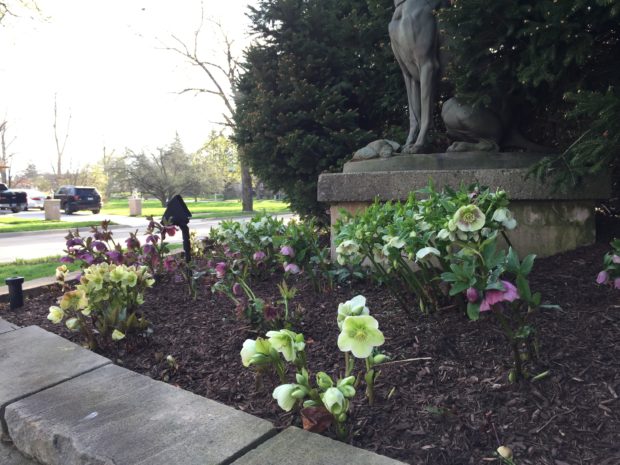 My Mom, however, was delighted with all of them. In retrospect, I attribute that to her taste, experience and sophistication in regards to garden plants. I had none of that going for me, in my 20’s. She thought her hellebores possessed a quiet and diminutive beauty. She organized an entire garden around them, and that moment when their blooming would kick off the spring season. There is something to be said for old fashioned flowers, whose size, stature, substance and color has not been tinkered with by a breeder. There are those who prefer the old fashioned feverfew to their button style double counterparts. Single flowered hollyhocks are so beautiful. The double flowered varieties look alarmingly like tissue papers suitable for a parade float.
My Mom, however, was delighted with all of them. In retrospect, I attribute that to her taste, experience and sophistication in regards to garden plants. I had none of that going for me, in my 20’s. She thought her hellebores possessed a quiet and diminutive beauty. She organized an entire garden around them, and that moment when their blooming would kick off the spring season. There is something to be said for old fashioned flowers, whose size, stature, substance and color has not been tinkered with by a breeder. There are those who prefer the old fashioned feverfew to their button style double counterparts. Single flowered hollyhocks are so beautiful. The double flowered varieties look alarmingly like tissue papers suitable for a parade float.
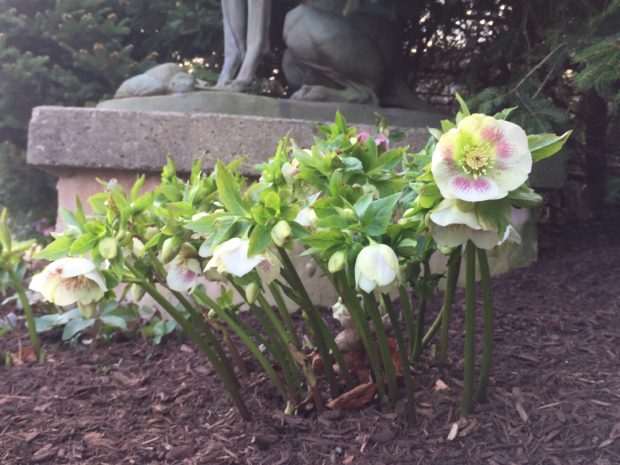 The irregularly blushing coloration of this Royal Heritage strain hellebore flower is charming, not arresting. I was lucky to have a single flower, by virtue of the support provided by the flower bud below it, face out. Otherwise, I would have no idea what the flowers look like. What a shy group this is!
The irregularly blushing coloration of this Royal Heritage strain hellebore flower is charming, not arresting. I was lucky to have a single flower, by virtue of the support provided by the flower bud below it, face out. Otherwise, I would have no idea what the flowers look like. What a shy group this is!
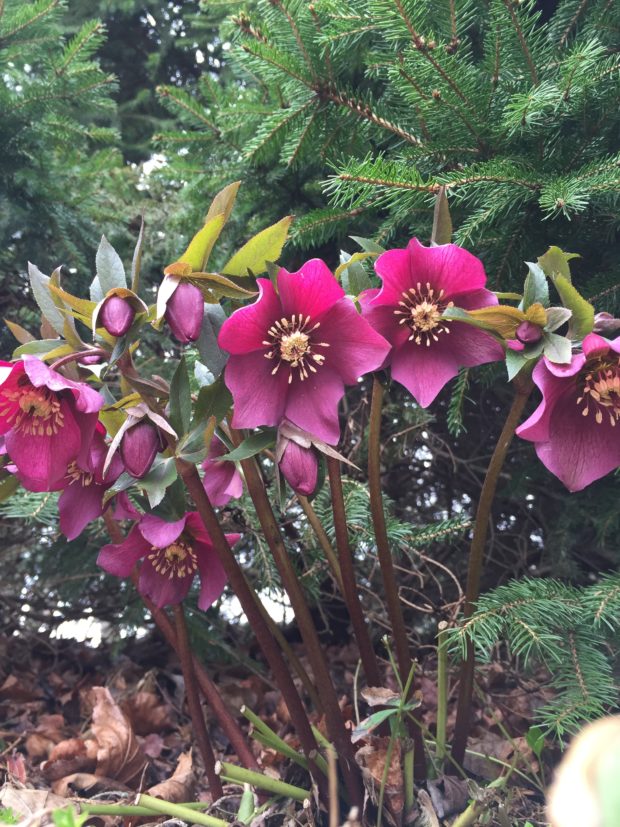 This rose pink seed grown hellebore from the same strain has small rather pointed petals that do not overlap so much. This particular plant has more side facing flowers than nodders, so it is easier to enjoy.
This rose pink seed grown hellebore from the same strain has small rather pointed petals that do not overlap so much. This particular plant has more side facing flowers than nodders, so it is easier to enjoy.
 This is one of my favorites from this old fashioned group. I picked the flower, and set it on the ground to photograph it. This is a good photograph for identifying the flower parts. What appear to be pink petals are actually modified petals known as sepals. Most flowers drop their petals one they are fertilized. But these pink sepals will age to green, and persist on the plant for many weeks. A group of sepals form a calyx, the purpose of which is to protect the flower, and its reproductive parts. The actual flower is comprised of short petals that have rolled up, closed, and formed tubes, or nectaries. In this picture, the nectaries are those green crescent shaped forms that encircle all the reproductive parts. The stamens, or male reproductive parts, have anthers at the top, which hold the pollen. They appear as cream white dots in the above picture. The female reproductive parts, the pointy shaped carpels, have not grown out yet. When they do, they will grow and enlarge into what will become the seeds. The sex lives of plants is complex and fascinating-and requires the assistance a third disinterested party, as in insects, wind, or bees.
This is one of my favorites from this old fashioned group. I picked the flower, and set it on the ground to photograph it. This is a good photograph for identifying the flower parts. What appear to be pink petals are actually modified petals known as sepals. Most flowers drop their petals one they are fertilized. But these pink sepals will age to green, and persist on the plant for many weeks. A group of sepals form a calyx, the purpose of which is to protect the flower, and its reproductive parts. The actual flower is comprised of short petals that have rolled up, closed, and formed tubes, or nectaries. In this picture, the nectaries are those green crescent shaped forms that encircle all the reproductive parts. The stamens, or male reproductive parts, have anthers at the top, which hold the pollen. They appear as cream white dots in the above picture. The female reproductive parts, the pointy shaped carpels, have not grown out yet. When they do, they will grow and enlarge into what will become the seeds. The sex lives of plants is complex and fascinating-and requires the assistance a third disinterested party, as in insects, wind, or bees.
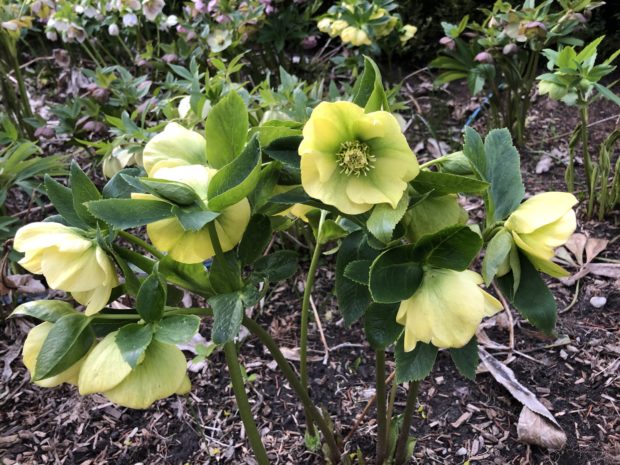 The newer cultivars of hellebores are quite astonishing. I still remember the first time I saw a yellow flowered hellebore. I could hardly believe it was real. The above pictured hellebore from the Spring Promise series is called Sally. It is a robust grower. As many flowers face out to the side as face down. Outfacing flowers are still able to shed rain water, limiting rot in the center of the flower. More flowers than not have 7 sepals, as opposed to the old fashioned 5. There is a good bit of overlap to the sepals, resulting in color that is richer and more brilliant.
The newer cultivars of hellebores are quite astonishing. I still remember the first time I saw a yellow flowered hellebore. I could hardly believe it was real. The above pictured hellebore from the Spring Promise series is called Sally. It is a robust grower. As many flowers face out to the side as face down. Outfacing flowers are still able to shed rain water, limiting rot in the center of the flower. More flowers than not have 7 sepals, as opposed to the old fashioned 5. There is a good bit of overlap to the sepals, resulting in color that is richer and more brilliant.
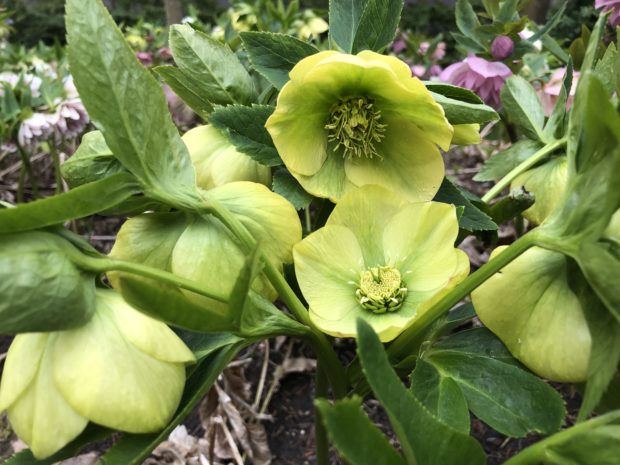 The size of the flowers is considerable larger than those on my older hybrids. 15 flowers of this size gives the plant the impact of a small shrub.
The size of the flowers is considerable larger than those on my older hybrids. 15 flowers of this size gives the plant the impact of a small shrub.
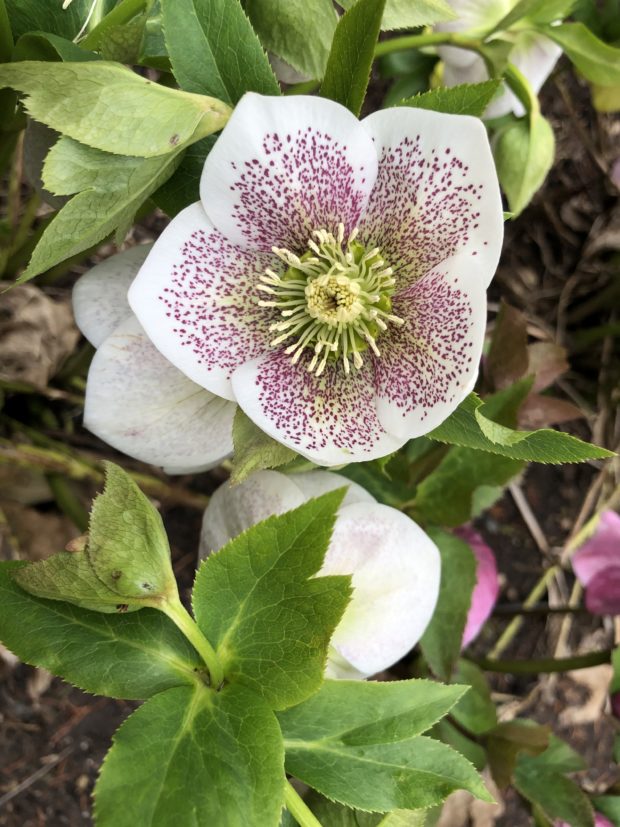 Also a member of the “Spring Promise” series is this named variety, Connie. The white sepals have plenty of substance, meaning they are thick enough to read bright white. The spots are a striking visual plus. I am sure there is every bit of 150 stamens on this flower. There are so many, the nectaries are almost completely obscured. It has an exotic, rather than charming appearance.
Also a member of the “Spring Promise” series is this named variety, Connie. The white sepals have plenty of substance, meaning they are thick enough to read bright white. The spots are a striking visual plus. I am sure there is every bit of 150 stamens on this flower. There are so many, the nectaries are almost completely obscured. It has an exotic, rather than charming appearance.
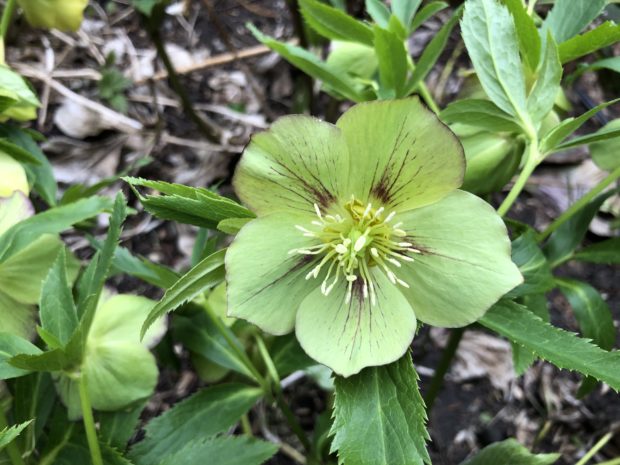 From the hybridizing efforts of Marietta Byrnes, her “Winter Jewels” strain known as Jade Star” features green flowers with maroon red markings and picotee edging. The original plants in her strain have large areas of plum and wine red over the green, but seedlings can vary considerably from the original.
From the hybridizing efforts of Marietta Byrnes, her “Winter Jewels” strain known as Jade Star” features green flowers with maroon red markings and picotee edging. The original plants in her strain have large areas of plum and wine red over the green, but seedlings can vary considerably from the original.
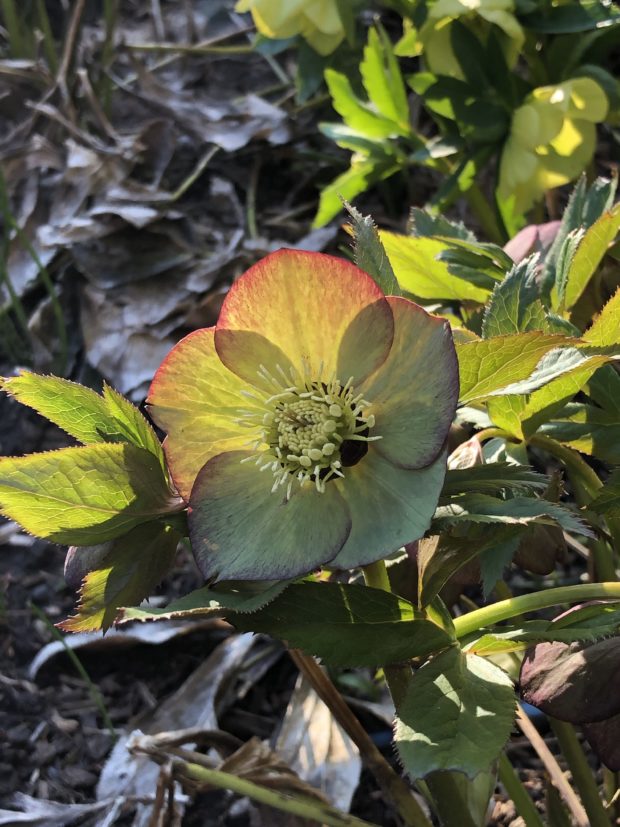 This is another version of Jade Star. Since hellebores from a strain do not come true to seed, it is best to pick them in flower so you know exactly what you will get. That said, I like every version of this moody colored hellebore strain I have seen.
This is another version of Jade Star. Since hellebores from a strain do not come true to seed, it is best to pick them in flower so you know exactly what you will get. That said, I like every version of this moody colored hellebore strain I have seen.
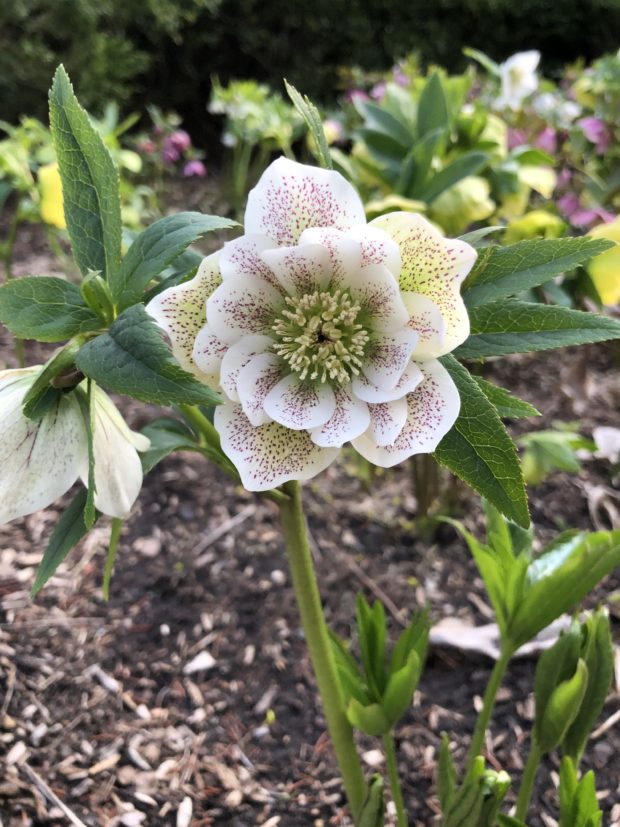 The double flowered hellebores are indeed showstopping. This particular plant is from the helleborus x hybridus Winter Dreams series “Elegance White”. In all the years I have had it, it has increased only modestly. But as reluctant as it is to put on weight, it is breathtaking, and well worth the wait.
The double flowered hellebores are indeed showstopping. This particular plant is from the helleborus x hybridus Winter Dreams series “Elegance White”. In all the years I have had it, it has increased only modestly. But as reluctant as it is to put on weight, it is breathtaking, and well worth the wait.
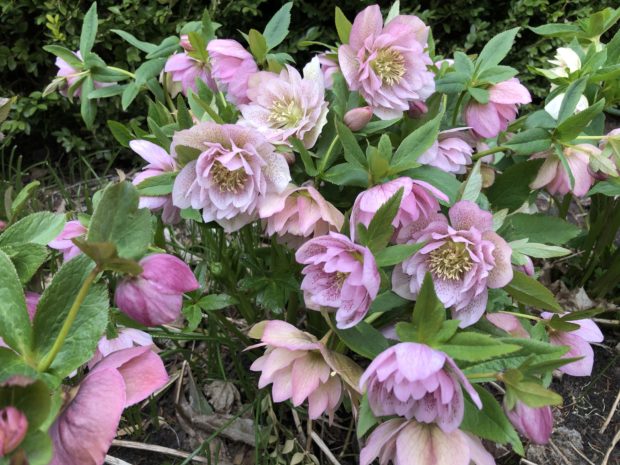 This double pink hellebore is also from the Spring Promise series, and is called “Frilly Kitty”. 7 years post planting, it is spectacular in size and bloom this year. Hellebores of any genetic background increase slowly, so the cost of good sized plants is considerable. This cultivar is vigorous and healthy, and gets no care from me besides supplemental water when it is dry. This is breathtaking example of what modern hybridizing has achieved. Is it better? I like having a range of cultivars both great and small.
This double pink hellebore is also from the Spring Promise series, and is called “Frilly Kitty”. 7 years post planting, it is spectacular in size and bloom this year. Hellebores of any genetic background increase slowly, so the cost of good sized plants is considerable. This cultivar is vigorous and healthy, and gets no care from me besides supplemental water when it is dry. This is breathtaking example of what modern hybridizing has achieved. Is it better? I like having a range of cultivars both great and small.
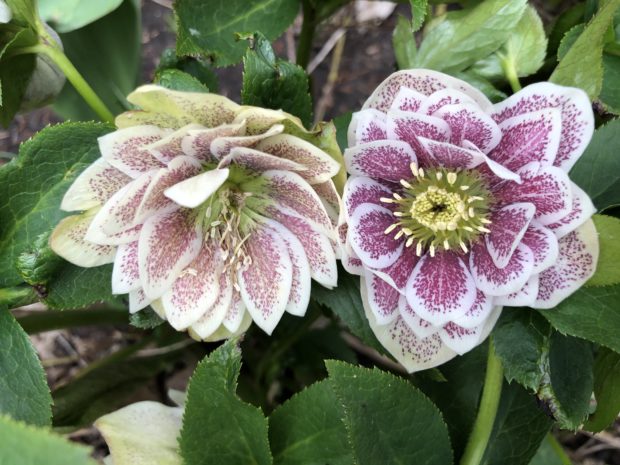 I cannot remember your name, but I am happy to be hosting you in my garden.
I cannot remember your name, but I am happy to be hosting you in my garden.
